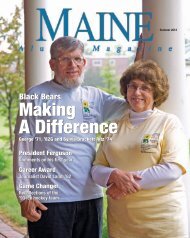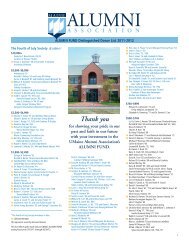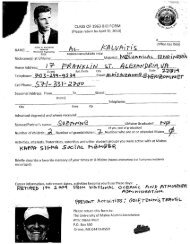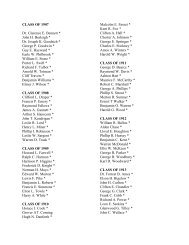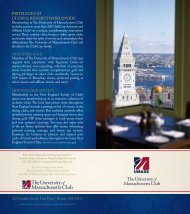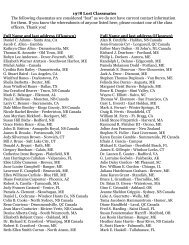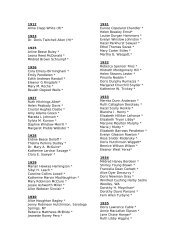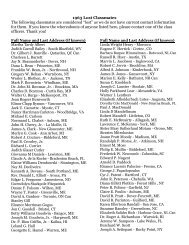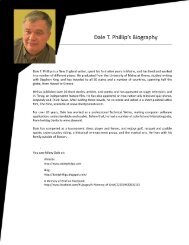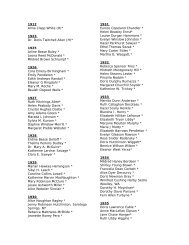UMaine's Diverse UMaine's Diverse - the University of Maine Alumni ...
UMaine's Diverse UMaine's Diverse - the University of Maine Alumni ...
UMaine's Diverse UMaine's Diverse - the University of Maine Alumni ...
Create successful ePaper yourself
Turn your PDF publications into a flip-book with our unique Google optimized e-Paper software.
<strong>Alumni</strong> Winter 2012_Layout 1 1/6/12 10:33 AM Page 20<br />
<strong>Alumni</strong> Pr<strong>of</strong>iles<br />
From Antarctica to Sou<strong>the</strong>ast Asia:<br />
Studying <strong>the</strong> Natural Enemies<br />
<strong>of</strong> Invasive Insects<br />
Paul W. Schaefer ’66, ’74 Ph.D.<br />
By Abigail Zelz<br />
It was late fall in 1962 and <strong>the</strong> wea<strong>the</strong>r in<br />
Orono was raw and miserable. Freshman<br />
Paul Schaefer found himself<br />
outside in <strong>the</strong> bitter cold <strong>University</strong> <strong>of</strong><br />
<strong>Maine</strong> forest measuring trees for a forestry<br />
course—measurements used to calculate<br />
board feet <strong>of</strong> lumber for commercial use.<br />
He was struck by how that perspective on<br />
trees contrasted with an entomology course<br />
he was also taking. In that course he was<br />
considering trees as food for insects.<br />
Calculating lumber left him cold, but he<br />
found <strong>the</strong> food for insects perspective fascinating.<br />
So that December, after a particularly<br />
uncomfortable, frigid session in <strong>the</strong><br />
forest when his gloved hands were too cold<br />
to handle <strong>the</strong> forestry measuring chain<br />
easily, <strong>the</strong> Rocky Hill, Connecticut, native<br />
changed his major to entomology.<br />
He was glad to leave <strong>the</strong> sleet and wind<br />
<strong>of</strong> <strong>the</strong> forest. And <strong>the</strong> diversity <strong>of</strong> insect<br />
species as well as employment opportunities<br />
in entomology appealed to him. Looking<br />
back, he credits U<strong>Maine</strong> with providing<br />
him with <strong>the</strong> foundation for his “delightful<br />
career.”<br />
Schaefer arrived on campus after four<br />
years in <strong>the</strong> Coast Guard, attracted by <strong>the</strong><br />
<strong>University</strong>’s wildlife management<br />
program. He settled into campus life,<br />
devoting most <strong>of</strong> his time to his job as resident<br />
assistant in Oak and Hannibal Hamlin<br />
halls and to his studies.<br />
Fieldwork and graduate school<br />
Graduating in 1966, he was accepted to <strong>the</strong><br />
master’s program at <strong>the</strong> <strong>University</strong> <strong>of</strong><br />
Hawaii. But before moving to Hawaii, he<br />
contacted that state’s Bishop Museum to<br />
inquire about becoming involved in some<br />
<strong>of</strong> <strong>the</strong>ir research. They replied with an <strong>of</strong>fer<br />
<strong>of</strong> field research in Antarctica. So prior to<br />
working on a master’s in <strong>the</strong> tropics, Schaefer<br />
joined o<strong>the</strong>r researchers at McMurdo<br />
Station and o<strong>the</strong>r locations in <strong>the</strong> vast,<br />
frozen landscape for an autumnal summer.<br />
“I spent a lot <strong>of</strong> time lying on my stomach,”<br />
he recalls, looking for and preserving<br />
free-living mites. These tiny creatures feed<br />
on lichens and mosses, living wherever<br />
<strong>the</strong>re is freestanding water. While admiring<br />
<strong>the</strong> dramatic geological features <strong>of</strong> <strong>the</strong> icy<br />
continent, he focused on <strong>the</strong> mites and<br />
parasites that live among <strong>the</strong> fea<strong>the</strong>rs <strong>of</strong><br />
skuas and penguins or <strong>the</strong> fur <strong>of</strong> seals.<br />
Shortly after his Antarctic experience,<br />
he married his wife, Jane, who had been a<br />
Peace Corps volunteer in Valdivia, Chile.<br />
They moved to Hawaii, where <strong>the</strong>y both<br />
earned master’s degrees. Afterward, <strong>the</strong>y<br />
celebrated by taking a circuitous trip<br />
through Asia and Europe, and back to<br />
Connecticut where Schaefer worked at <strong>the</strong><br />
Connecticut Agricultural Experiment<br />
Station (CAES) in New Haven. He had<br />
spent summers at CAES as an undergraduate,<br />
working with <strong>the</strong> staff on infestations<br />
<strong>of</strong> <strong>the</strong> gypsy moth in Connecticut’s oak<br />
forests. When one <strong>of</strong> his supervisors, David<br />
E. Leonard, left CAES to join <strong>the</strong> faculty at<br />
U<strong>Maine</strong>, he suggested Schaefer consider<br />
applying to Orono’s Ph.D. program.<br />
Schaefer returned to Orono in 1970 with<br />
his young family and pursued graduate<br />
studies under <strong>the</strong> guidance <strong>of</strong> Leonard,<br />
Eben Osgood, Geddes Simpson, and John<br />
Diamond. At <strong>the</strong> time, Leonard was<br />
researching <strong>the</strong> North American gypsy<br />
moth, a pesky species that was defoliating<br />
hardwood forests in New England and<br />
spreading. The population <strong>of</strong> <strong>the</strong> destructive<br />
gypsy moth was increasing, infesting<br />
densely populated areas and feasting on a<br />
variety <strong>of</strong> trees and shrubs in forests, neighborhoods,<br />
parks, and gardens. Because <strong>the</strong><br />
gypsy moth survives on a wide variety <strong>of</strong><br />
trees and shrubs—from oak, apple, poplar,<br />
willow, and hickory—it can migrate to<br />
different areas. In severe outbreaks, <strong>the</strong><br />
moths consume enough tree leaves to<br />
weaken and sometimes kill <strong>the</strong> trees. The<br />
infestation peaked in New England in <strong>the</strong><br />
early 1980s, but in <strong>the</strong> early 1970s, gypsy<br />
moths were a real nuisance, destroying<br />
20 MAINE <strong>Alumni</strong> Magazine




